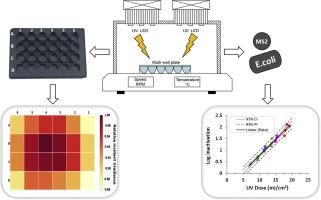当前位置:
X-MOL 学术
›
J. Photochem. Photobiol. B Biol.
›
论文详情
Our official English website, www.x-mol.net, welcomes your feedback! (Note: you will need to create a separate account there.)
Multiwell plates for obtaining a rapid microbial dose-response curve in UV-LED systems.
Journal of Photochemistry and Photobiology B: Biology ( IF 5.4 ) Pub Date : 2020-03-30 , DOI: 10.1016/j.jphotobiol.2020.111865 Yifaat Betzalel 1 , Yoram Gerchman 2 , Vered Cohen-Yaniv 1 , Hadas Mamane 1
Journal of Photochemistry and Photobiology B: Biology ( IF 5.4 ) Pub Date : 2020-03-30 , DOI: 10.1016/j.jphotobiol.2020.111865 Yifaat Betzalel 1 , Yoram Gerchman 2 , Vered Cohen-Yaniv 1 , Hadas Mamane 1
Affiliation

|
UV light-emitting diodes (UV-LEDs) have emerged as a new technology for water disinfection. Multiwell plates are a common tool in biological research, but they have never been used for UVC/UVB-inactivation experiments of microorganisms. In this study, a novel, rapid and simple UVC/UVB-inactivation assay was developed for a UV-LED system using a multiwell plate setup (96- and 24-well plates). The relative incident irradiance distribution across the exposed area was examined by spectroradiometry and nitrate-nitrite uniformity assay. The two methods showed a good correlation and high distribution factors (>0.89 and >0.94 for 96- and 24-well plates, respectively). In addition, the potential of the new system for determining disinfection efficacy of E. coli and MS2 coliphage by UV-LEDs emitting at central wavelengths of 265 nm and 285 nm was demonstrated. The inactivation rate constants were comparable to those obtained using UV-LED systems with the conventional dish (or beaker) setup, but the multiwell plate method allowed for many more repetitions. The proposed system is an alternative for UV-inactivation dose-response assay, especially when screening assays are desired, since it has the advantage of being fast, comprehensive (with a large number of simultaneous replicates) and easily adapted to various applications as UV-LED based photocatalysis experiments, UV effect on biofilm formation and UV-based AOP degradation experiments.
中文翻译:

用于在UV-LED系统中获得快速微生物剂量响应曲线的多孔板。
紫外线发光二极管(UV-LEDs)已经成为一种用于水消毒的新技术。多孔板是生物学研究中的常用工具,但从未用于微生物的UVC / UVB灭活实验。在这项研究中,为使用多孔板设置(96孔板和24孔板)的UV-LED系统开发了一种新颖,快速,简单的UVC / UVB灭活测定法。通过分光光度法和硝酸盐-亚硝酸盐均匀性测定法检查了整个曝光区域的相对入射辐照度分布。两种方法显示出良好的相关性和较高的分布因子(96孔板和24孔板分别> 0.89和> 0.94)。此外,新系统具有确定E.消毒功效的潜力。通过在265nm和285nm的中心波长发射的UV-LED证实了大肠杆菌和MS2大肠杆菌噬菌体。灭活速率常数可与使用具有常规培养皿(或烧杯)设置的UV-LED系统获得的常数相比,但是多孔板方法可进行更多重复。拟议的系统是紫外线灭活剂量反应测定的替代方法,尤其是在需要筛选测定时,因为它具有快速,全面(具有大量同时重复)的优点,并且易于适应各种应用,例如紫外线基于LED的光催化实验,紫外线对生物膜形成的影响以及基于紫外线的AOP降解实验。但是多孔板方法允许更多重复。拟议的系统是紫外线灭活剂量反应测定的替代方法,尤其是在需要筛选测定时,因为它具有快速,全面(具有大量同时重复)的优点,并且易于适应各种应用,例如紫外线基于LED的光催化实验,紫外线对生物膜形成的影响以及基于紫外线的AOP降解实验。但是多孔板方法允许更多重复。拟议的系统是紫外线灭活剂量反应测定的替代方法,尤其是在需要筛选测定时,因为它具有快速,全面(具有大量同时重复)的优点,并且易于适应各种应用,例如紫外线基于LED的光催化实验,紫外线对生物膜形成的影响以及基于紫外线的AOP降解实验。
更新日期:2020-03-30
中文翻译:

用于在UV-LED系统中获得快速微生物剂量响应曲线的多孔板。
紫外线发光二极管(UV-LEDs)已经成为一种用于水消毒的新技术。多孔板是生物学研究中的常用工具,但从未用于微生物的UVC / UVB灭活实验。在这项研究中,为使用多孔板设置(96孔板和24孔板)的UV-LED系统开发了一种新颖,快速,简单的UVC / UVB灭活测定法。通过分光光度法和硝酸盐-亚硝酸盐均匀性测定法检查了整个曝光区域的相对入射辐照度分布。两种方法显示出良好的相关性和较高的分布因子(96孔板和24孔板分别> 0.89和> 0.94)。此外,新系统具有确定E.消毒功效的潜力。通过在265nm和285nm的中心波长发射的UV-LED证实了大肠杆菌和MS2大肠杆菌噬菌体。灭活速率常数可与使用具有常规培养皿(或烧杯)设置的UV-LED系统获得的常数相比,但是多孔板方法可进行更多重复。拟议的系统是紫外线灭活剂量反应测定的替代方法,尤其是在需要筛选测定时,因为它具有快速,全面(具有大量同时重复)的优点,并且易于适应各种应用,例如紫外线基于LED的光催化实验,紫外线对生物膜形成的影响以及基于紫外线的AOP降解实验。但是多孔板方法允许更多重复。拟议的系统是紫外线灭活剂量反应测定的替代方法,尤其是在需要筛选测定时,因为它具有快速,全面(具有大量同时重复)的优点,并且易于适应各种应用,例如紫外线基于LED的光催化实验,紫外线对生物膜形成的影响以及基于紫外线的AOP降解实验。但是多孔板方法允许更多重复。拟议的系统是紫外线灭活剂量反应测定的替代方法,尤其是在需要筛选测定时,因为它具有快速,全面(具有大量同时重复)的优点,并且易于适应各种应用,例如紫外线基于LED的光催化实验,紫外线对生物膜形成的影响以及基于紫外线的AOP降解实验。



























 京公网安备 11010802027423号
京公网安备 11010802027423号